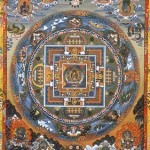 The Tibetan Book of the Dead or Bardo Thodol provides a map of the stages of life, which in this case, occurs not in a straight line but in a circle:
The Tibetan Book of the Dead or Bardo Thodol provides a map of the stages of life, which in this case, occurs not in a straight line but in a circle:
- The Chi-Kha Bardo – this state occurs at the moment of death, when the dying person has the potential to perceive The Clear Light of Ultimate Reality, and recognize it as his own ultimate being. If the soul does this, it merges with the light and no longer has to be reborn. This encounter, however, is quite an overwhelming experience, to put it mildly, and the individual may shrink back from this Light in fear. If it does so, then the weight of its own karma will pull it into the next bardo.
- The Chhos-Nyid Bardo – this part of the journey is where the soul encounters “Peaceful Deities” and “Wrathful Deities,” which are outer projections of its karma, or past experiences over innumerable rebirths. The soul is counselled not to become attracted or repulsed by these deities, but to regard them as emanations of its own illusory self. If the soul can do this, it achieves liberation. However, if the soul ends up getting “caught” by one of these entities, it may end up hanging out in one of six possible “lokas” or “worlds,” including those of the hungry ghosts, the warrior demons, the devas (or angels), the hell dwellers, the bestial world of animals, or back into the world of human beings (see next bardo).
- The Sid-Pa Bardo – this is the state where the soul, driven by the winds of its own karma, begins to seek rebirth. It encounters the Lord of Death, who subjects the soul to a kind of “Judgment Day” that can be quite a painful ordeal. Eventually it observes pairs of couples copulating (potential future parents), and goes through a kind of pre-birth Oedipal complex where it feels anger toward the same sex parent and lust toward the opposite sex parent. Since there is no chance for liberation at this point, the soul is counselled to choose a “womb” that will optimize its chances of getting a favorable incarnation for future attempts at freedom from rebirth.
- The Skyes-Nas Bardo (“Life” ) – this is the bardo of ordinary waking consciousness experienced by a soul during its incarnation as a human being.
- The Rmi-Lam Bardo (“Dream”) – this is the bardo of dream consciousness that occurs when we are experiencing rapid eye movement (REM) during sleep, or when we are in a semi-waking state of active imagination during our waking hours.
- The Bsam-Gtan Bardo (“Meditation”) – this is the bardo of “trance consciousness” when we are in a deep state of meditation during our waking hours.
- At this point, we begin again with The Chi-Kha Bardo, and the circle of death and rebirth starts up once again. The only way out is through liberation.
—————
For more information about the stages of life in different cultures and traditions, see Thomas Armstrong’s The Human Odyssey: Navigating the Twelve Stages of Life
This article was brought to you by Thomas Armstrong, Ph.D. and www.institute4learning.com.
Follow me on Twitter: @Dr_Armstrong



















